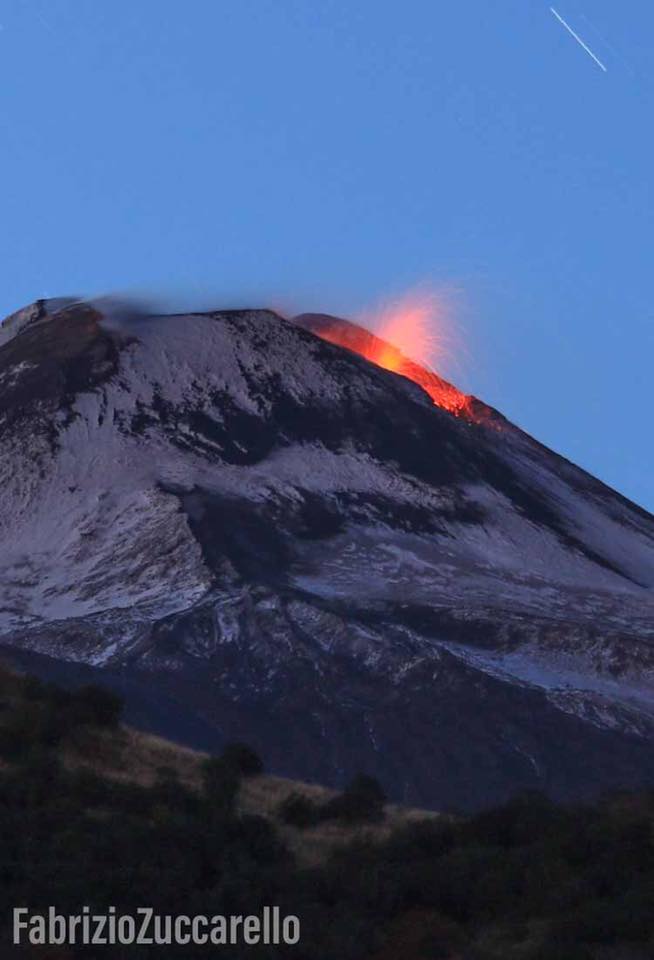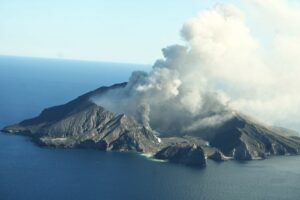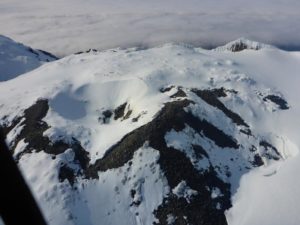November 08 , 2018.
Chile , Planchon Peteroa :
Special Report on Volcanic Activity (REAV), Maule Region, 07 November 2018, 11.30 local time (mainland Chile).
The National Geological and Mining Service of Chile (Sernageomin) publishes the following information, obtained from the surveillance equipment of the National Volcanic Monitoring Network (RNVV), processed and analyzed at the Volcanological Observatory of the Southern Andes (OVDAS):
Today, Wednesday 07 November 2018, at 10:24 local time (1324 GMT), the surveillance cameras installed near the Planchon Peteroa volcanic complex recorded an emission of low-altitude (1000m) particulate matter, which dispersed East-South-East direction. It should be noted that this event presented a weak seismic activity, it was not registered precursors signals to this event.
This photo of Planchón-Peteroa was taken during a series of overflights on April 26, 27 and 29, 2011. A column of ash rose from the active crater and tephra visibly covered much of the snow immediately at Southeast and southwest of the crater. With the permission of Orlando Rivera, Exploraciones Mineras Andinas S.A.
In this context, it is possible that new events such as the one recorded will occur, and include more energy, as described in some previous activity reports.
OBSERVATIONS:
At the time of issuing this report, no new events of similar characteristics were recorded as signs of an increase in the seismic signal.
The level of volcanic technical alert remains at the level: Yellow.
Sernageomin continues online monitoring and will inform in a timely manner about any changes observed.
Source : Sernageomin.
Chile , Nevados de Chillan :
36.868 ° S, 71.378 ° W
Altitude: 3180 m
Special Report on Volcanic Activity (REAV), Bio Bio Region, Nevados Volcanic Complex of Chillan, 07 November 2018, 23:47 local time (mainland Chile).
The National Geological and Mining Service of Chile (Sernageomin) publishes the following PRELIMINARY information, obtained from monitoring equipment of the National Volcanic Monitoring Network (NVRN), processed and analyzed at the Volcanological Observatory of the Southern Andes (OVDAS) :
Today, Wednesday 07 November 2018, at 23:03 local time (02:03 UTC), the monitoring stations installed near the volcanic complex Nevados de Chillan recorded the occurrence of an explosive event, with earthquake associated with fluid dynamics inside the volcanic system (long period type).
The characteristics of the larger magnitude event, after its analysis, are as follows:
TIME OF ORIGIN: 23h03 Local time (02h03 UTC)
LATITUDE: 36.862 ° S
LONGITUDE: 72.376 ° W
DEPTH: 1.1 KM
REDUCED MOVEMENT: 1093 cm2
ACOUSTIC SIGNAL: 13.8 Pa reduced to 1 km.
OBSERVATIONS:
The explosion was associated with the recording of a seismic signal, with a reduced displacement value (average seismic energy) considered high. The IP camera installed by the OVDAS, was able to record the incandescence associated with the emission of gases and the pyroclasts at high temperature, the latter falling in the vicinity of the active crater. The observed events suggest a partial destruction of the lava dome under construction inside the crater. At this time, no other abnormal signals have been recorded.
The level of volcanic technical alert remains at the level: Orange.
Sernageomin continues online monitoring and will inform in a timely manner about any changes observed.
The Servicio Nacional de Geología and Minería (SERNAGEOMIN) Observatorio Volcanológico de Los Andes del Sur (OVDAS) and ONEMI reported the continuing, slow growth of the lava dome in Nevados de Chillán’s Nicanor Crater during 30 October-6 November. Seismicity was characterized by moderate levels of long-period and tremor events, often associated with explosion signals. Gas emissions persisted, and sometimes contained ash. Periodic explosions sometimes ejected material that was deposited around the crater. At night incandescence emanated from the lava dome as well as from ejected ballistics. The Alert Level remained at Orange, the second highest level on a four-color scale, and residents were reminded not to approach the crater within 3 km. ONEMI maintained an Alert Level Yellow (the middle level on a three-color scale) for the communities of Pinto, Coihueco, and San Fabián.
Source : Sernageomin , GVP.
Photo : Sernageomin
Italy / Sicily , Etna :
37.748°N, 14.999°E
Elevation 3295 m
INGV reported that during 29 October-4 November activity at Etna was characterized by gas emissions at the summit craters, with periodic Strombolian activity from vents in Bocca Nuova, Northeast Crater (NEC), SE Crater (SEC), and New Southeast Crater (NSEC). Strombolian explosions at NSEC were interspersed with long pauses from a few minutes to a few hours. The explosions sometimes produced ash emissions that quickly dispersed; ashfall was deposited around the crater and in the Valle del Bove.
Strombolian activity and gas emissions were characteristic of the N vent in the W part of Bocca Nuova’s (BN-1) crater floor. Spattering from the southernmost vent was also visible, as well as gas emissions. Gas emissions at Voragine Crater from a vent on the E rim of the crater were less intense compared to previous months. NEC activity was characterized by Strombolian explosions sometimes accompanied by minor ash emissions.
Source : INGV , GVP.
Photo : Fabrizio Zuccarello / Facebook. ( via Boris Behncke).
Indonesia , Merapi :
7.54°S, 110.446°E
Elevation 2910 m
PVMBG reported that during 26 October-1 November the lava dome in Merapi’s summit crater grew slowly at a rate of 2,900 cubic meters per day, slower than the previous week. By 31 October the volume of the dome, based on photos from the SE sector, was an estimated 248,000 cubic meters. White emissions of variable density rose a maximum of 50 m above the summit. The Alert Level remained at 2 (on a scale of 1-4), and residents were warned to remain outside of the 3-km exclusion zone.
Level II Activity Level (WASPADA). The Merapi (2968 m altitude) does not experience a continuous eruption.
Since yesterday and until this morning, it was clearly visible that the volcano was covered with fog. Crater white smoke was observed 75 m above the summit. The wind is blowing weakly to the East – Northeast.
Thanks to the seismographs, on November 7, 2018, it was recorded:
24 avalanche earthquakes
8 low frequency earthquakes
10 hybrid earthquakes
1 shallow volcanic earthquake
6 emission earthquakes
Visual aspect of the new lava dome of Mount Merapi, seen from the hamlet of Balerante, Kemalang, Klaten, Central Java, Tuesday 9/10/2018. The black bumps on the top are clearly visible in sunny weather. The smoke is thick enough to flow into the openings of the southeast sector of the crater.
Recommendation:
Mount Merapi’s climbing activity is temporarily not recommended, except for investigation and research related to disaster mitigation efforts.
An area of radius 3 km around the summit is prohibited to the activities of the population.
If there is a significant change in Mount Merapi activity, Mount Merapi activity status will be immediately reviewed.
It is recommended that the regional government make the current state of Mount Merapi known to the community.
VONA: The latest VONA code issued a GREEN color code on June 3, 2018 at 8:39 pm, due to the presence of white smoke emission activities with a column height of 3768 m or approximately 800 m above the summit.
Source : GVP , PVMBG.
Photo : Mads. Tribun Jogja/ Setya Krisna Sumarga.









